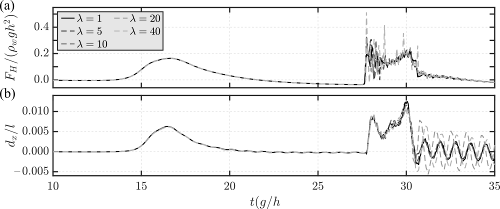|
Wave-structure interaction |
|
Introduction |
|
Tommaso’s PhD study focuses on wave impact on flexible and rigid plates based on both the numerical and laboratory modelling. In the first part of the PhD published in Attili et al. (2021), Tommaso investigated tsunami impacts on dams with the numerical model solids4foam as shown in Fig. 1. This investigation was motivated by the research gap in predicting tsunami effects on dams, including forces, pressures and 3D effects. A total of 72 numerical tests have been conducted with a range of waves impacting dams of different inclinations. In addition, 3D experiments have been performed with straight and arch dams and different wave impact angles. The numerical wave forces agreed with available prediction methods and a new empirical equation to predict the wave run-ups was proposed. |

|
|

|
Personal research website of Dr Valentin Heller |
|
Selected publications |
|
Journals Attili, T., Heller, V., Triantafyllou, S. (2023a). Scaling approaches and scale effects in wave-flexible structure interaction. Journal of Fluids and Structures 123, 103987 (https://doi.org/10.1016/j.jfluidstructs.2023.103987). Attili, T., Heller, V., Triantafyllou, S. (2023b). Wave impact on rigid and flexible plates. Coastal Engineering 182:104302 (https://doi.org/10.1016/j.coastaleng.2023.104302). Attili, T., Heller, V., Triantafyllou, S. (2021). A numerical investigation of tsunamis impacting dams. Coastal Engineering 196:103942 (https://authors.elsevier.com/sd/article/S0378-3839(21)00101-0). Others Attili, T., Heller, V., Triantafyllou, S. (2023). Numerical modelling of waves impacting rigid and flexible structures. SIAM Conference on Mathematical & Computational Issues in the Geosciences. Attili, T., Heller, V., Triantafyllou, S. (2022). Numerical investigation of impulse waves impacting on dams. Proc. 39th IAHR World Congress, 2222-2229. Attili, T., Heller, V., Triantafyllou, S. (2022). Numerical investigation of waves interacting with rigid and flexible plates. Proc. 39th IAHR World Congress, 4438-4447. Attili, T., Heller, V., Triantafyllou, S. (2022). Simulations of solitary waves impacting onshore plates. Proc. YCSEC 2022. Attili, T., Heller, V., Triantafyllou, S. (2021). Numerical study of impulse waves impacting dams. 16th UK Young Coastal Scientists and Engineers Conference, virtual, 29-30th March 2021. Atilli, T., Heller, V., Triantafyllou, S. (2020). Numerical modelling of impulse wave forces on dams. 1st IAHR Young Professionals Congress, online, 17-18th November 2020, 186-187. |
|
Tommaso was then investigating waves interacting with plates of different stiffnesses (Attili et al., 2023b). For this scope the numerical model solids4foam was validated with a laboratory experiment from Kimmoun et al. (2009). A range of numerical tests have been conducted involving plates located either offshore or onshore (Fig. 2). Forces, run-ups and plate deformations have been analysed. Further validation of the numerical model solids4foam was carried out based on own laboratory tests. The latest article Attili et al. (2023a) addresses scaling approaches and scale effects in wave-flexible structure interaction (WFSI). Tommaso quantified scale effects for both breaking and non-breaking wave impact (Fig. 3) and established a new and versatile scaling approach for WFSI. The findings of this study aim to provide new physical insight into wave-structure interaction and support the design of coastal and offshore structures. |
|
Fig. 2. Snapshot series of a solitary wave impacting an onshore plate with Young’s modulus E = 1 GPa and pressure contours in kPa (Attili et al., 2022).
|
|
Last modified: 11.10.2023 |
|
|
|
Fig. 1. Snapshot series of a solitary wave impact on a dam with overtopping and pressure counters in MPa (Attili et al., 2021).
|


|
Fig. 3. Time series of wave impact on a flexible wall modelled at 5 different scales based on Froude-Cauchy scaling. None-breaking waves (left) show no scale effects whilst breaking waves (right) show significant scale effects in relation to both (a) forces and (b) plate displacements (after Attili et al., 2023a).
|
